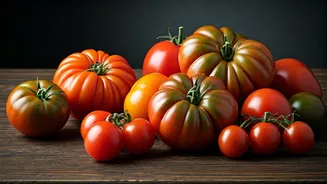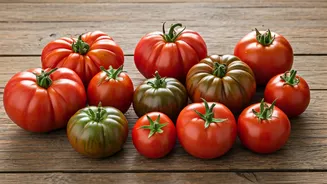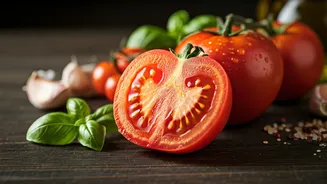Italian Tomato Magic
Italy's contribution to tomato-based dishes is vast, with pasta sauces being perhaps the most recognizable. Consider the simplicity of a classic Marinara
sauce, made with tomatoes, garlic, herbs, and a touch of olive oil. Then, there's the rich and complex Bolognese, a slow-cooked meat sauce simmered with tomatoes, vegetables, and wine. Beyond sauces, Italy showcases tomatoes in dishes like Bruschetta, featuring toasted bread topped with diced tomatoes, basil, and balsamic glaze, or Caprese salad, a vibrant combination of tomatoes, mozzarella, and fresh basil, drizzled with olive oil, showcasing simplicity and fresh ingredients. These dishes highlight Italy's appreciation for fresh, high-quality ingredients and simple yet delicious preparations. The focus is always on letting the tomatoes' natural sweetness and acidity shine through, paired with complementary flavors like garlic, basil, and olive oil.
Spanish Tomato Symphony
Spain's culinary heritage prominently features the tomato, with gazpacho standing out as a chilled soup perfect for warmer climates. Gazpacho is a blend of raw tomatoes, cucumbers, peppers, onions, garlic, and vinegar. The combination makes it refreshing and vibrant. Another famous dish is 'Pan con tomate', or bread with tomato. This simple yet satisfying snack involves rubbing a halved tomato over toasted bread, drizzling it with olive oil, and sometimes adding garlic or a sprinkle of salt. Beyond these, Spanish cuisine features tomatoes in stews like 'cocido madrileño', a hearty chickpea-based stew often including tomatoes to add depth to the flavor. These dishes exemplify Spain's use of simple, fresh ingredients and careful seasoning, where tomatoes' sweetness and acidity are carefully balanced with other components.
French Tomato Elegance
France elevates tomatoes into sophisticated dishes, demonstrating its culinary prowess. Ratatouille is a vegetable stew with tomatoes at its core, gently simmered with eggplant, zucchini, bell peppers, onions, and herbs like thyme and bay leaf. The slow cooking process allows the flavors of the vegetables, and the tomatoes, to meld together in perfect harmony. Another French classic, Provençal-style dishes, frequently includes tomatoes along with olive oil, garlic, and herbs de Provence, showcasing the region's culinary techniques. Whether in stews, sauces, or baked dishes, French cuisine utilizes tomatoes to create refined and flavorful meals, emphasizing the importance of technique and balance.
Mexican Tomato Fiesta
Mexican cuisine is vibrant and tomato-centric, as evidenced by its use in various salsas and sauces. Salsa roja, the classic red salsa, is typically made with tomatoes, onions, chilies, and cilantro, offering a blend of flavors and textures. Salsa verde uses tomatillos, a relative of the tomato, for a tangy, herbaceous taste. In addition, Mexican dishes frequently incorporate tomatoes in braised meats, stews, and rice dishes, using the fruit to add a burst of acidity and sweetness. Guacamole, though primarily avocado-based, often includes tomatoes for a pop of freshness. Tomatoes play a crucial role, providing both flavor and balance to many dishes.
Indian Tomato Spice
Indian cuisine makes extensive use of tomatoes, particularly in curries and sauces. Tomato-based curries form the base of many popular dishes, such as butter chicken and various vegetable curries, creating a rich foundation for the spices. Tomatoes are often combined with onions, ginger, garlic, and a blend of aromatic spices like turmeric, cumin, and coriander, creating complex and flavorful sauces. Dishes such as chana masala (chickpea curry) and dal makhani (black lentil curry) often include tomato to balance the richness. The fruit is essential, providing the tanginess and depth, which balances the spices, making it an integral element of Indian culinary traditions.
Middle Eastern Tomato Flair
The Middle East embraces tomatoes in its diverse dishes. Shakshuka, a popular breakfast dish, features eggs poached in a flavorful tomato sauce simmered with peppers, onions, and spices, such as cumin and paprika. In the Middle East, tomatoes are often incorporated into stews such as 'fatteh' and 'moujadara', contributing to the savory flavor profile. Additionally, tomatoes are often used in salads, such as fattoush, a bread salad with toasted pita, fresh herbs, and a lemon-tomato dressing. These dishes highlight the use of fresh produce, herbs, and spices to create vibrant and flavorful meals.
Thai Tomato Zing
Thailand's culinary style also features tomatoes, bringing balance to its spicy-sweet-sour profile. Green papaya salad, or 'som tum', often contains tomatoes, along with papaya, chilies, lime juice, and peanuts. They also use them in their curries like green or red curry, where the tomatoes meld with coconut milk, chilies, and herbs to create complex flavor profiles. Thai cuisine uses tomatoes in various forms, including fresh, cooked, and pureed, adding a burst of freshness and acidity to dishes. The fruit is an essential component, enhancing the vibrant tastes unique to Thai cooking.
American Tomato Innovation
American cuisine presents tomatoes in several ways, from classic dishes to modern innovations. Tomato soup, often paired with grilled cheese, is a comforting favorite. Pizza is another example, with its tomato sauce base and diverse toppings. Beyond these, innovative chefs experiment with tomatoes in various ways. Sun-dried tomatoes are a common ingredient in salads and pastas. Heirloom tomatoes, with their unique flavors and colors, feature in salads and other culinary creations. The fruit is also a core ingredient in ketchup, a widely popular condiment, highlighting the fruit's versatility and adaptability in American cuisine.
Japanese Tomato Simplicity
Japan offers a unique perspective on using tomatoes in cooking. While the tomato isn't the primary ingredient in many traditional dishes, it is utilized to create depth. For example, some Japanese ramen recipes may incorporate tomatoes for extra flavor. Tomatoes, alongside other fresh ingredients, can be used in side dishes, salads, and sauces. They also appear in fusion dishes, blending Japanese culinary techniques with other culinary traditions. The fruit is a versatile ingredient, providing a burst of acidity, sweetness, and color to various dishes, demonstrating its adaptability within the framework of Japanese cooking.
Global Tomato Conclusion
This culinary journey around the world showcases the versatility of tomatoes. From Italy's pasta sauces to Mexico's salsas, each culture has incorporated the fruit into its dishes. Whether used in soups, stews, sauces, or salads, tomatoes add flavor and complexity. This exploration celebrates the diversity of global cuisine, where the simple tomato becomes a key ingredient in countless delicious creations. The exploration emphasized the fruit's ability to be prepared in myriad ways, adapting to the preferences of different countries and cultures, making it an indispensable part of world cuisine.











